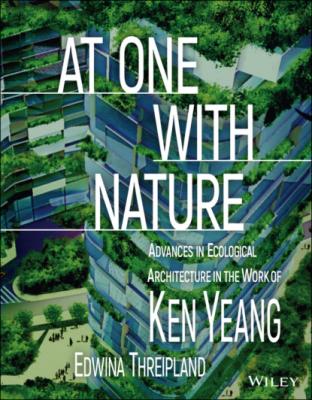At One with Nature. Ken Yeang
Читать онлайн.| Название | At One with Nature |
|---|---|
| Автор произведения | Ken Yeang |
| Жанр | Архитектура |
| Серия | |
| Издательство | Архитектура |
| Год выпуска | 0 |
| isbn | 9781119527879 |
of protests by the group calling itself Extinction Rebellion. It is increasingly apparent
that the air we breathe, the water we drink, the earth we plant in, the food we eat,
and − crucially − the overall integration of our natural and built environments have all
been compromised. This can arguably be largely attributed to decades of governments
marginalising environmental policies and societies undervaluing ecological designs.
In this context, Ken Yeang’s prescience as an architect is impressive and highly
judicious; his doctorate in the early 1970s was titled, ‘Theoretical Framework for
the Ecological Design and Planning of the Built Environment’. This topic drove his
dissertation (which was agreed with John Meunier, then Head of Graduate Studies at
Cambridge University) and became his life‘s agenda when he started a practice. We
share some academic lineage, both of us having been students at the Department of
Architecture there, influenced by many of the same minds from the faculty, such as
Professor Marcial Echenique (who became head of the Department), Dr. Dean Hawkes
(who left to become Professor at the School of Architecture at Cardiff University), and
Peter Carl.
After university, Ken continued to further pursue and develop his work on ecological
design on both theoretical and practical levels. He developed a model framework through
the biological integration of sets of ecoinfrastructures, namely natural, technological,
water management, hydrology systems, and societal factors. In practice, he was able
to interpret this abstract theory into physical forms through his architecture and his
masterplans, and his built projects from over 40 years ago and was already looking at
ways to integrate designed systems more benignly with nature. Through both passive
and controlled methods of reducing energy demands, he has for decades looked at
making buildings and communities run as complete ecosystems, with minimal external
energy supply. It is evident that developing those theoretical subsystems is integral to
making his architectural designs fully credible.
INTRODUCTION xiii
xiv INTRODUCTION
His most recent work – which is explored in this book – has honed that rigorous
research towards architecture specifically mimicking nature’s processes. He now
integrates the human-made with the landscape completely, because his current theoretical
work is on ‘ecomimesis’ – the idea of designing by emulating and replicating by design
the attributes in nature’s ecosystems. He is among the few architects whose built work
is properly ecocentric, in terms of designing and building wholly based around the science
of ecology. This is perhaps what differentiates his work and ideas from other ‘green’
architects, many whose credentials are essentially driven by engineering technology, or
are simply based on green accreditation systems such as LEED or BREEAM.
There are specific patterns to the manner in which Ken consistently assimilates
biotic constituents with the inorganic structures of the built environment. For example,
one device regularly employed involves constructing sustainable territories within the
wider development and then populating them with selected indigenous fauna species,
to augment the local habitat. These are coordinated with selected flora typologies to
create a multifarious ‘biodiversity matrix’ that goes much deeper than merely adding
greenery or landscaping to his built forms. The book specifically focuses on his practice’s
latest projects, defining and explaining every cutting-edge tested technology, and newest
innovation within each scheme. This is coupled with a pursuit of the aesthetics of
ecological design, seeking to define in terms of form and materiality what a green building
or masterplan could and should look like.
Ken’s continued persistence in advancing green design towards ecocentrism
makes it environmentally significant; the Guardian newspaper named him as one of the
‘50 People Who Could Save The Planet’ in 2008. That urgency is now increasingly being
realised globally, and his work has never been more pertinent or visionary. Ken’s belief
is that up until the last decade, architects sought only to prevent further impairments
of the natural environment. Today – with the extent of devastation and its impact on the
biosphere evident – the design effort must become a full ‘race and rescue’ mission. His
ideas are therefore relevant not only to those in the design professions but also to others
worldwide who share his concern for the future of the planet.
INTRODUCTION xv
xii INTRODUCTION
GREEN TECHNOLOGIES xvii
Ecological design as the seamless
and benign biointegration of
ecoinfrastructures
© Ken Yeang (2021)
xviii INTRODUCTION
FAUNA & HABITATS xix
Species research as basis
for creation of habitats
within the built environment
© Ken Yeang (2021)
xx INTRODUCTION
Built environment as bioengineered ‘constructed ecosystems’
LIM KOK WING UNIVERSITY MDTC xxi
LimKokWing University
Ecomasterplanning must start with green infrastructures
